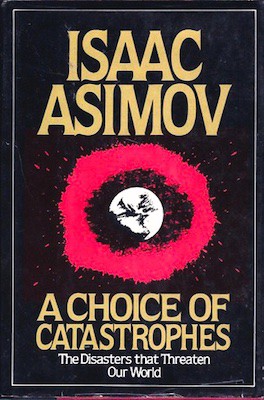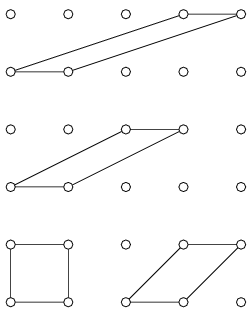I still remember with pleasure, and a touch of dismay, a book by Isaac Asimov that I read as a boy. It was titled A choice of catastrophes (Simon and Schuster, 1979) and analyzed in detail the numerous ways in which humanity could have ended up destroyed. Asimov?s examination ranged from threats created by ourselves, such as atomic wars and pollution, to natural disasters of Earth origin (tsunamis, earthquakes, glaciations, colossal volcanic eruptions), to threats from space: fall of asteroids and comets, death of the Sun, supernova explosions, cosmic rays and more.

However, Asimov had not thought of another possible sudden end of humanity (or at least of what seems to us to be humanity), that is, someone who, from the outside, unplugs the powerful supercomputer in which our existence is simulated. This unpredictable act would put to an end our existence abruptly. Our virtual, digital awareness would disappear in the blink of an eye, with the entire Universe in which we are immersed with our thoughts, our conscience, our human relationships, and our perceptions of the physical world.
A supercomputer that simulates the real world is, in fact, the latest and most modern embodiment of an ancient idea, which occupies a primary place in the history of philosophy: i.e., the idea that our daily experience of the world is false, is the result of an illusion.
 Bust of Plato [Vatican Museum, Rome]
Bust of Plato [Vatican Museum, Rome]
The myth of Plato?s cave is a classic example. We human beings ? claimed the Athenian philosopher in the Republic (4th century BC) ? are like prisoners in a cave, which confuse the shadows of people and things of the outside world, projected on the back wall of the cave, for real beings, without realizing that those shadows are only faded copies of the beings that live outside the cave.
Another example is the evil genius imagined by the French philosopher Descartes in his Meditations on First Philosophy of 1641:
So I shall suppose that some malicious, powerful, cunning demon has done all he can to deceive me ? rather than this being done by God, who is supremely good and the source of truth. I shall think that the sky, the air, the earth, colours, shapes, sounds and all external things are merely dreams that the demon has contrived as traps for my judgment. I shall consider myself as having no hands or eyes, or flesh, or blood or senses, but as having falsely believed that I had all these things. I shall stubbornly persist in this train of thought.
From the doubt that the whole world around us is a deception, Descartes drew the certainty, if nothing else, of his existence as a thinking being. But he could not free himself from the doubt that our ideas about the world are false, if not relying on the fact that they come from God, a perfect and infinite being, who, as such, cannot be deceiving us [Discourse on the Method, 1637]:
But if we didn?t know that everything real and true within us comes from a perfect and infinite being, then, however vivid and clear our ideas were, we would have no reason to be sure that they had the perfection of being true.
 Ren Descartes [National Library of Medicine, Bethesda, Maryland]
Ren Descartes [National Library of Medicine, Bethesda, Maryland]
The idea that the Universe around us is a sort of grand illusion probably arises from the mediated nature of knowledge. We do not know things as they are in themselves, but as they appear to us through the sensory channels and cognitive abilities of which nature has endowed us with. We know from experience that the senses and reason can be deceiving to some extent. Even the most abstract and complex knowledge derive from simple ?bricks.? If those bricks that underlie our knowledge are for some reason at least partly illusory, everything we have built on them can also be illusory, even if it appears internally coherent to us.
The current form that this ancient idea has assumed is precisely that of digital simulation. In the last 60 years, the exponential growth of computer power has brought from science fiction to the realm of plausible things the possibility of creating simulated worlds more and more perfect, populated by beings like us, unaware of living within a simulation. The Matrix trilogy is a popular and successful cinematic transposition of such a possibility.
Bostrom?s trilemma
Philosopher Nick Bostrom, a professor at the University of Oxford, used the idea of an almost unlimited future growth in computing power as the basis for logically formulating the simulation problem. In a 2003 article, he proposed to the public?s attention a trilemma, a series of three disjunctive (that is, mutually exclusive) propositions, one of which must necessarily be true:
- the human species is very likely to go extinct before reaching a ?post-human? stage (meaning by ?post-human? the level of a technologically advanced civilization, endowed with computers incomparably more powerful than today?s most powerful supercomputers);
- any post-human civilization is extremely unlikely to run a significant number of simulations of their evolutionary history (or variations thereof);
- we are almost certainly living in a computer simulation.
Bostrom?s trilemma says, in layman?s terms, that if our descendants do not become extinct sooner, then they will reach a post-human technological level that will allow them to create simulations of their ancestors, indistinguishable from true reality for the simulated minds living within those simulated Universes.
 Philosopher Nick Bostrom [USI Events]
Philosopher Nick Bostrom [USI Events]
Now, it may happen that those post-human descendants, for some reason, decide not to use their technological capacity to run such simulations or to do so only in sporadic cases. If, however, one or more civilizations of any future epoch decide to resort heavily to the use of simulations capable of recreating their ancestors, at a certain point, the number of simulated minds will become exponentially high compared to the minds existing in natural bodies. In such a case, it is then very, very likely that each of us is not an actual human being, but rather a digital mind within a simulation created by the descendants of humans like us. A mind that thinks it lives in the real physical world, but that inhabits a digital universe.
Bostrom?s three propositions are based on the idea that the mind and self-awareness are characteristics that can arise even outside the biological bodies created by evolution. According to this hypothesis, fairly advanced technologies could create a simulation of the Universe so rich, complete, and realistic that, at a certain point, it would produce thinking beings like us. To such beings, the simulated reality in which they live must necessarily appear as the only actual reality, because it is in the interest of the simulation?s creators that the simulated ancestors did not know to live in a universe created especially for them.
An example of the application of such an idea is the Westworld science fiction series, in which there is a theme park where the places of the West?s epic have been recreated, inhabited by an android population with digital minds. Androids were built to satisfy the most violent and perverse desires of wealthy human vacationers, but they don?t know it. They perceive themselves as ordinary human beings, who live (and more often than not die) in the ?true? world, a world of stagecoaches and horses which, for them, is the present. Still, for the post-human society that manages the simulation, it is the past.
 A scene from the TV series Westworld [HBO]
A scene from the TV series Westworld [HBO]
A surprising consequence follows from Bostrom?s trilemma. The belief that there are significant possibilities that we could one day become a post-human civilization, capable of creating simulations of our ancestors, is false unless we admit that we ourselves are the inhabitants of a simulation created ad hoc by a post-human civilization.
Bostrom himself does not think he indeed lives in a simulation, although he gives this possibility a rather high probability. In proposing the trilemma, his purpose was not to convince the world that we are all simulated beings, but only to induce us to reflect on the possible consequences of the present trend. If the computer power will continue to grow in the coming centuries at the current exponential rate, then there is indeed a high probability that the world of our daily experience is not physically real, but it is a simulated world, created by distant descendants of human beings like us (who, however, are not us).
How to find out if we live in a simulated universe or not?
Therefore, If the possibility exists that our world is a simulation, how can we notice it?
The simplest way that comes to mind, for those who know the limits of programming, is through software bugs. Even the most sophisticated digital program has flaws, and, sooner or later, an unexpected series of events occurs that existing routines in the program are unable to handle.
The fact is that, if we really live in a simulated universe and the simulation?s creators have done an excellent job, no simulated mind would retain the memory of having stumbled upon a bug in the program. What would prevent, in fact, the simulation?s creators from reprogramming the memory of simulated ancestors, erasing dangerous memories whenever any clue raises doubts and questions about the nature of the world in which they live?
However, there is perhaps another possibility. Simulation?s creators could decide never to intervene, even if the simulated minds discover dangerous clues, for reasons that have to do, for example, with the scientificity of the results of their simulations. In this case, at least in principle, you can discover that you are living inside a simulated universe.
This possibility concerns, rather than software errors, the limits of the available computing power. Even a very advanced hyper-technological civilization will have to deal with the calculation limits, whatever they are, of their computers. Therefore, they must have studied a way to save the resources to be used.
 IBM?s Summit supercomputer can complete 200 quadrillion mathematical equations per second. It weighs 340 tons and hosts 9,216 processors made by IBM, plus 27,648 graphics processors made by Nvidia. Summit needs over 15,000 litres of water per minute to be cooled, and the electricity that keeps it running is enough to light 8,100 homes [Oak Ridge National Laboratory]
IBM?s Summit supercomputer can complete 200 quadrillion mathematical equations per second. It weighs 340 tons and hosts 9,216 processors made by IBM, plus 27,648 graphics processors made by Nvidia. Summit needs over 15,000 litres of water per minute to be cooled, and the electricity that keeps it running is enough to light 8,100 homes [Oak Ridge National Laboratory]
For example, if the simulation?s goal is to observe the evolution of a post-human civilization?s ancestors on Earth, is it necessary to simulate all the infinite stars and planetary systems of the approximately two trillion galaxies in the observable Universe? It would not be much more practical and cheaper to approximate only the farthest objects, so to deceive our most powerful telescopes and persuade simulated astronomers to believe that they are observing real, very distant galaxies?
Going to the realm of the infinitely small, is it indispensable to reproduce the nuclei of all atoms up to the scale of the femtometers (10?? meters, that is, one-millionth of a millionth of a millimeter)? Wouldn?t it be much cheaper to allocate the computational resources necessary to simulate them only when someone within the simulated Universe takes the trouble to make observations on the femtometer scale?
Also, in this case, if the simulation?s creators were good enough to manage the computing power at their disposal, the minds in the simulation could not notice anything. Whenever they pushed their gaze far into space or to the limits of the observable in the submicroscopic world, they would find only things that appeared real in all respects, because they were consistent with what they expected to see.
In short, to bring to light clues of the simulated nature of our Universe, the only possibility is to hope to be by chance the protagonists of a somewhat primitive simulation, even with the wealth of means available for a post-human civilization. In this case, the computational resources allocated for the simulation could be so limited that we could discover, by pushing the observation of the details up to the maximum limits, that our Universe is not physically real, but it is a simulated one.
 If we lived in a simulated universe and reached the maximum level of detail possible in the simulation, we would notice that the objects would have dimensions equal to exact multiples of the minimum possible spacing in the grid. It would not be possible to have objects or spaces of smaller or intermediate dimensions.
If we lived in a simulated universe and reached the maximum level of detail possible in the simulation, we would notice that the objects would have dimensions equal to exact multiples of the minimum possible spacing in the grid. It would not be possible to have objects or spaces of smaller or intermediate dimensions.
But what would these clues be? Mainly one: the fact that if we lived in a simulation with strict limits of computing resources, at a certain point, the space-time would cease to be continuous; instead, it would appear to consist of discrete intervals, as if it had some sort of granularity.
The cause of this would be that, at the base of a simulated universe, there should be a grid of points that make up the minimum intervals along which you can move. Therefore, at a sufficiently small scale, it would be found that one cannot pass from position 1 to position 2 by passing through an arbitrary position 1.5, but that there is only the possibility of jumping from 1 to 2. Or that objects cannot have size 1.5, but only size 1 or size 2. Below size 1, finally, no further structure would appear.
Looking for evidence
Is there any experimental evidence that the Universe we live in possesses such granularity? Not so far. A study published in 2015, authored by Eric Perlman and five others, had nothing to do directly with the hypothesis of the simulated Universe but achieved results that proved interesting for what concerns the possible ?granularity? of space-time.
The idea behind Perlman and colleagues? study was to find experimental verification of the fact that space-time structure could be subject, on sufficiently small scales, to fluctuations predicted by quantum mechanics. There are several theoretical models of quantum gravity which provide that, at the level of the so-called Planck length (about 1.6 10?? meters), space-time is not continuous, but forms a sort of ?foam? made of small bubbles, which are the effect of quantum fluctuations.
Such a strange submicroscopic reality is not easy to represent. A useful comparison may be to imagine flying over the ocean aboard an airplane at high altitude. From up there, the surface of the water appears continuous, flat, and uniform. But, going down in height, crests and troughs of the waves begin to appear. Going even lower, you finally get to see the foam that boils on the crests of the waves.
 Artist?s impression of quantum foam bubbling at the Planck scale [Physics / PicFair]
Artist?s impression of quantum foam bubbling at the Planck scale [Physics / PicFair]
Directly observing quantum foam is impossible. If it exists, it would appear at scales billions of billions of times smaller than that of an atomic nucleus. However, its effects could be observed on the opposite scale of lengths, that of the most distant galaxies. And this is precisely the experimental verification attempted by Perlman and colleagues in the study mentioned above.
In fact, according to the quantum gravity models put to the test by the authors, the fluctuations that form the quantum foam would accumulate with time and distance, ending up blurring, or even erasing, images of celestial objects billions of light-years away. Therefore, the study?s authors analyzed the images of some distant quasars, acquired in X-rays and gamma rays from space and terrestrial telescopes, looking for blur effects that can confirm or disprove the quantum gravity models being considered.
The images of the quasars observed in the high energies, however, turned out to be clear and defined, as might be expected if space-time kept its uniform and continuous structure, free of quantum ?bubbles,? even on a submicroscopic scale.
In short, the results of the study suggest that at least two models of the Universe underlying the research are incomplete or to be discarded. The examination of the light from those quasars is compatible with a continuous space, free of irregularities, at least up to distances 1,000 times less than the size of the nucleus of a hydrogen atom.
This result allows us to discard, up to that submicroscopic scale of magnitude, the hypothesis that we live in a ?primitive? simulation, with a grid of minimum distances capable of being revealed by the degradation of the images of celestial objects as far away as quasars and blazars.
One last clue that could reveal that we live in a simulated universe is the distribution of cosmic rays at the highest energies. A study published in 2014 in The European Physical Journal A, authored by Silas R. Beane, Zohreh Davoudi and Martin J. Savage, discusses this topic.
The three calculated that the distribution of the most energetic cosmic rays should exhibit a symmetry breaking if we lived in a simulated universe with limited computational resources. In fact, something similar to a limit of this kind appears in the experimental data on the most energetic cosmic rays. Still, it may have nothing to do with the theory of the simulated Universe.
 Elon Musk during an interview in which he talks about his idea that we live in a simulated universe
Elon Musk during an interview in which he talks about his idea that we live in a simulated universe
In conclusion, so far, we have no tool that can safely determine whether we live in a real physical world or a simulated universe. Some, like Elon Musk, are firmly convinced that we are the protagonists of a simulation. Others, such as physicists Lisa Randall and Max Tegmark, think not. Finally, the authors of the 2014 study are on a position that we could define as possibilist, as can be understood from the closings of their article:
Nevertheless, assuming that the Universe is finite and therefore the resources of potential simulators are finite, then a volume containing a simulation will be finite and a lattice spacing must be non-zero, and therefore in principle there always remains the possibility for the simulated to discover the simulators.
Provided that discovering a ?lattice? is the indication of a simulated universe and not, more simply, the discovery of an intrinsic limit of nature, due to its laws.


